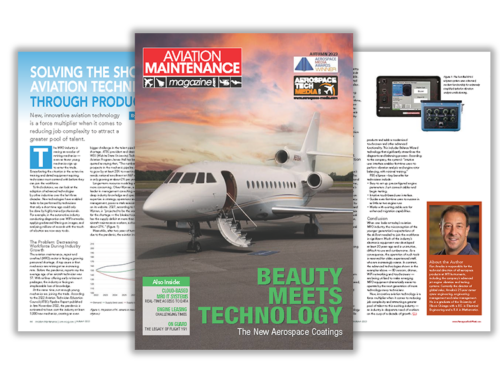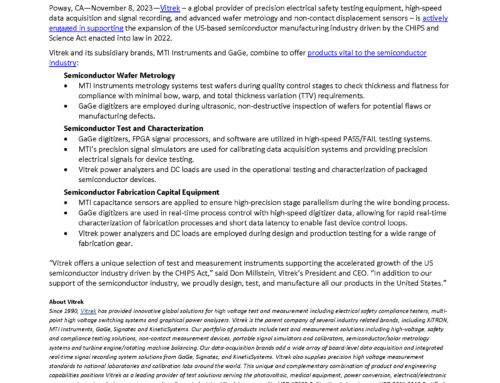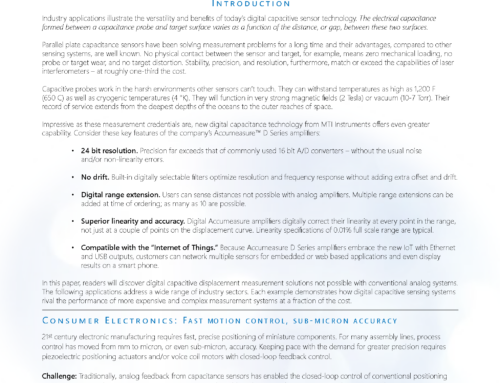A Comprehensive Guide to Non-Contact Sensors and Their Applications
Sensors, both contact and non-contact, are crucial devices that allow the monitoring, detection, and reaction to conditions in an environment or within a process or piece of equipment. While myriad types of sensors exist and are designed to monitor varying conditions, all of them can be characterized as being one of two types — contact sensors and non-contact sensors. We’ll focus on the latter, diving into different technologies, types, and applications of non-contact sensor technology; but first, let’s explore what differentiates contact and non-contact sensors.
Contact vs. Non-Contact Sensors: What’s the Difference?
Measuring, monitoring, or detecting a particular condition can be accomplished by means of direct physical contact or indirect sensing. When direct physical contact is utilized, it would be considered a contact sensor. Think of a thermometer immersed in a swimming pool or a float that sits inside of a tank and drives a gauge.
Non-contact sensors, on the other hand, function without the need to physically touch the object or system being monitored. Infrared thermometers — such as those used by physicians to take a patient’s temperature — are an example of this. Non-contact sensing devices typically depend on technologies based on electrical, magnetic, optical, or sonic principles.
Common Non-Contact Sensor Technologies and Real-World Applications
Capacitive Sensor Technology
These types of non-contact sensors detect a change in capacitance to provide pertinent information about the movement or position of a given target. A capacitor has the ability to store energy in an electric field amidst two plates known as electrodes. With this technology, the capacitance sensor functions as one plate of the capacitor, with the target functioning as the other. If a fixed frequency AC current is applied, the amplitude of the AC voltage provides a measure of the distance between the sensor and target.
Common applications of capacitive sensor technology include position sensing as well as dynamic and thickness measurement. Capacitive sensors can be used for part detection on workstations, conveyors, and robots, as well as for counting and checking liquid levels. Everyday devices, such as digital audio players, smartphones, and tablets, leverage capacitive sensing touchscreen as input devices. These sensors can also replace mechanical buttons.
Laser Displacement Sensor Technology
Laser displacement sensors — also referred to as laser triangulation sensors — are suited for measuring distances, position, and displacement of targets at extended ranges with high accuracy. Thanks to their versatility, these sensors are used in many applications and industries for displacement measurement, including everything from automated process control and research and development testing to OEM integration, inventory management, and beyond. They are intended for the measuring and checking of position, dimensions, surface profile, vibrations, sorting, and sensing of technological objects, as well as measuring levels of liquid and bulk materials.
Inductive Sensor Technology
Inductive sensors use magnetic fields generated in the coil to determine the motion or the position of a target. One type of inductive sensor technology utilizes Eddy currents and is used when targets are conductive. This type of sensor uses an alternating current applied to a coil to generate an alternating magnetic field. When the target approaches the sensor, the field induces currents — Eddy currents — in the target. These currents generate a secondary magnetic field, which opposes the sensor’s. The interaction can be measured and used to indicate the distance between the sensor and target.
Eddy current sensors are suitable for applications in harsh industrial environments — as a result of their tolerance for oil, dirt, moisture, and magnetic interference fields — and areas where access is restricted. Some examples of this technology at work include measuring vibrations of cylinder movements in an internal combustion engine or the thickness of sheet metal in roller gaps.
Get the Right Non-Contact Sensor for Your Application
When it comes to investing in non-contact measurement tools, it’s paramount to secure sensors and equipment that deliver on accuracy, reliability, and ease of use. That’s where a trusted partner like MTI Instruments steps in. We have helped countless organizations across a wide variety of sectors with state-of-the-art products that produce the results they need to en/mti-instruments/non-contact-measurement/sure success.
For more information about capacitors and their uses or other measuring tools and sensors, get in touch with MTI Instruments today.



